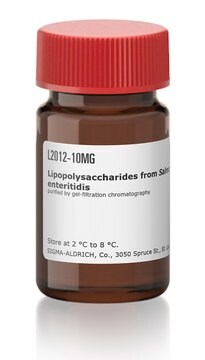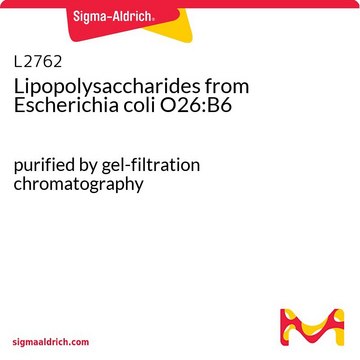L4774
Lipopolysaccharides from Salmonella enterica serotype enteritidis
purified by ion-exchange chromatography
Sinônimo(s):
LPS
Faça loginpara ver os preços organizacionais e de contrato
About This Item
Produtos recomendados
fonte biológica
Salmonella enterica (Serotype enteritidis)
Nível de qualidade
Formulário
lyophilized powder
purificado por
ion-exchange chromatography
Impurezas
<1% Protein
<1% RNA
Condições de expedição
ambient
temperatura de armazenamento
2-8°C
Procurando produtos similares? Visita Guia de comparação de produtos
Descrição geral
This product is extracted from Salmonella enteritidis and purified by ion exchange. The source strain is ATCC 13076. Lipopolysaccharide from Salmonella enteritidis is mutagenic in murine spleen cells and causes a plaque-forming response in those cells.
Aplicação
Lipopolysaccharides (LPSs) are characteristic components of the cell wall of Gram-negative bacteria. LPS and its lipid A moiety stimulate cells of the innate immune system by the Toll-like receptor 4 (TLR4).
Ações bioquímicas/fisiológicas
Lipopolysaccharides (LPS) are localized in the outer layer of the membrane and are, in noncapsulated strains, exposed on the cell surface. They contribute to the integrity of the outer membrane, and protect the cell against the action of bile salts and lipophilic antibiotics.
Nota de preparo
The product is soluble in water (5 mg/ml) or cell culture medium (1 mg/ml) yielding a hazy, faint yellow solution. A more concentrated, though still hazy, solution (20 mg/ml) has been achieved in aqueous saline after vortexing and warming to 70-80 oC. Lipopolysaccharides are molecules that form micelles in every solvent. Hazy solutions are observed in water and phosphate buffered saline. Organic solvents do not give clearer solutions. Methanol yields a turbid suspension with floaters, while water yields a homogeneously hazy solution.
Outras notas
To gain a comprehensive understanding of our extensive range of Lipopolysaccharides for your research, we encourage you to visit our Carbohydrates Category page.
produto relacionado
Nº do produto
Descrição
Preços
Código de classe de armazenamento
11 - Combustible Solids
Classe de risco de água (WGK)
WGK 3
Ponto de fulgor (°F)
Not applicable
Ponto de fulgor (°C)
Not applicable
Equipamento de proteção individual
Eyeshields, Gloves, type N95 (US)
Escolha uma das versões mais recentes:
Já possui este produto?
Encontre a documentação dos produtos que você adquiriu recentemente na biblioteca de documentos.
Os clientes também visualizaram
Yelena Y Grinberg et al.
PloS one, 6(4), e19294-e19294 (2011-05-05)
Spreading depression (SD) is thought to cause migraine aura, and perhaps migraine, and includes a transient loss of synaptic activity preceded and followed by increased neuronal excitability. Activated microglia influence neuronal activity and play an important role in homeostatic synaptic
Basilia Zingarelli et al.
Immunology, 124(1), 51-57 (2007-11-22)
Peroxisome proliferator activated receptor-gamma (PPARgamma) has been reported to exert anti-inflammatory properties in endotoxic shock and sepsis. One phenomenon that alters the inflammatory response to endotoxin [lipopolysaccharide (LPS)] is endotoxin tolerance, which is caused by previous exposure to endotoxin. Here
A Zarbock et al.
British journal of pharmacology, 155(3), 357-364 (2008-07-01)
Acute lung injury (ALI) remains a major challenge in critical care medicine. Both neutrophils and chemokines have been proposed as key components in the development of ALI. The main chemokine receptor on neutrophils is CXCR2, which regulates neutrophil recruitment and
Jörg Reutershan et al.
European journal of immunology, 39(6), 1597-1607 (2009-06-06)
The Duffy antigen receptor for chemokines (DARC) has a high affinity for CC and CXC chemokines. However, it lacks the ability to induce cell responses that are typical for classical chemokine receptors. The role of DARC in inflammatory conditions remains
Guangming Ren et al.
The EMBO journal, 38(6) (2019-02-23)
Deubiquitination of NLRP3 has been suggested to contribute to inflammasome activation, but the roles and molecular mechanisms are still unclear. We here demonstrate that ABRO1, a subunit of the BRISC deubiquitinase complex, is necessary for optimal NLRP3-ASC complex formation, ASC
Nossa equipe de cientistas tem experiência em todas as áreas de pesquisa, incluindo Life Sciences, ciência de materiais, síntese química, cromatografia, química analítica e muitas outras.
Entre em contato com a assistência técnica


